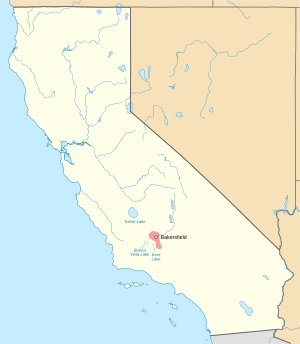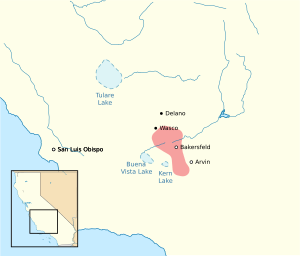Yawelmani Yokuts facts for kids
Quick facts for kids Yawelmani |
|
|---|---|
| Yowlumne Yaw'lamnin ṭeexil |
|

Yawelmani sentence documented by A. L. Kroeber
|
|
| Native to | California |
| Native speakers | 20–25 fluent and semispeakers (2007) |
| Language family |
Yok-Utian
|

Historical distribution of Yawelmani
|
|
Yawelmani Yokuts (also known as Yowlumne) is a special language that is now endangered. It was historically spoken by the Yokuts people. They lived along the Kern River in the Central Valley of California, north of Kern Lake. Today, most people who speak Yawelmani live near the Tule River Reservation.
Contents
What's in a Name?
When experts talk about the language, they often call it Yawelmani. However, the people who are part of the tribe usually call it Yowlumne.
Modern speakers of Yawelmani have their own names for their language. They use inyana, which means "Indian," and yaw'lamnin ṭeexil, which means "speech of the Yowlumne."
Sounds of Yawelmani
Every language has its own unique sounds, and Yawelmani is no different! It has a set of consonant sounds and vowel sounds that make it special. Some of these sounds might be different from what you hear in English.
For example, Yawelmani has different kinds of "stop" sounds, which are made by completely blocking air in your mouth and then releasing it. It also has a variety of vowel sounds, some of which can be short or long.
How Words Change
Yawelmani has a system called "case." This means that words, especially nouns (names of people, places, or things), change their endings depending on their role in a sentence. It helps you understand who is doing what, or who something belongs to.
For example, an ending might show if a word is the subject of a sentence (the one doing the action) or the object (the one receiving the action). A famous expert named A. L. Kroeber studied this language and wrote about its case system in 1907.
Who Speaks Yawelmani?
Sadly, not many people speak Yawelmani today. In 2011, an estimate by Victor Golla suggested that there were only about 20 to 25 people who could speak Yawelmani fluently or semi-fluently. This makes it a very endangered language.
Efforts to Keep the Language Alive
People are working hard to save the Yawelmani language! In 1993, a program called the Master-Apprentice Language Learning Program started. This program helped teach Yawelmani to tribal members who didn't know it before. It also encouraged older speakers to use the language more often. These efforts have been successful in helping to bring the language back to life.
Words to Learn
Here are some images showing words in Yawelmani, including parts of the body and family terms:




